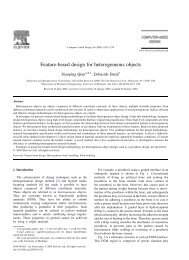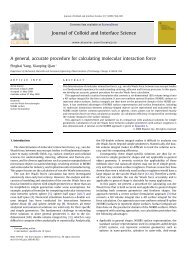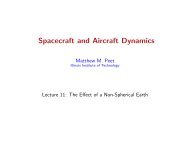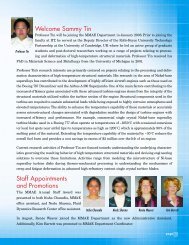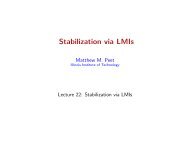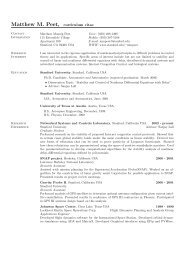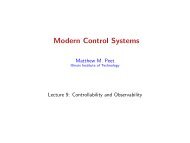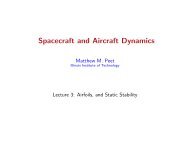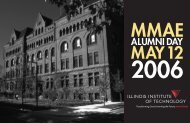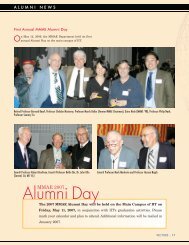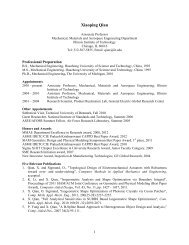Spacecraft and Aircraft Dynamics - Lecture 5 - Illinois Institute of ...
Spacecraft and Aircraft Dynamics - Lecture 5 - Illinois Institute of ...
Spacecraft and Aircraft Dynamics - Lecture 5 - Illinois Institute of ...
Create successful ePaper yourself
Turn your PDF publications into a flip-book with our unique Google optimized e-Paper software.
<strong>Spacecraft</strong> <strong>and</strong> <strong>Aircraft</strong> <strong>Dynamics</strong>Matthew M. Peet<strong>Illinois</strong> <strong>Institute</strong> <strong>of</strong> Technology<strong>Lecture</strong> 5: Hyperbolic Orbits
IntroductionIn this <strong>Lecture</strong>, you will learn:Hyperbolic orbits• Hyperbolic Anomaly• Kepler’s Equation, Again.• How to find r <strong>and</strong> vA Mission Design ExampleIntroduction to the Orbital PlaneM. Peet <strong>Lecture</strong> 5: <strong>Spacecraft</strong> <strong>Dynamics</strong> 2 / 26
Given t, find r <strong>and</strong> vFor elliptic orbits:1. Given time, t, solve for Mean AnomalyM(t) = nt2. Given Mean Anomaly, solve for Eccentric AnomalyM(t) = E −esinE3. Given eccentric anomaly, solve for true anomaly4. Given true anomaly, solve for rtan f 2 = √1+e1−e tan E 2r(t) = a(1−e2 )1+ecosf(t)Does this work for Hyperbolic Orbits? Lets recall the angles.M. Peet <strong>Lecture</strong> 5: <strong>Spacecraft</strong> <strong>Dynamics</strong> 3 / 26
What are these Angles?Eccentric Anomaly, E• Measured from center <strong>of</strong> ellipse to a auxiliary reference circle.M. Peet <strong>Lecture</strong> 5: <strong>Spacecraft</strong> <strong>Dynamics</strong> 5 / 26
What are these Angles?Mean AnomalyM(t) = 2π t T = 2π A PFVA Ellipse• The fraction <strong>of</strong> area <strong>of</strong> the ellipse which has been swept out, in radians.M. Peet <strong>Lecture</strong> 5: <strong>Spacecraft</strong> <strong>Dynamics</strong> 6 / 26
Relationships between M, E, <strong>and</strong> fM vs. EM. Peet <strong>Lecture</strong> 5: <strong>Spacecraft</strong> <strong>Dynamics</strong> 7 / 26
Relationships between M, E, <strong>and</strong> fM vs. fM. Peet <strong>Lecture</strong> 5: <strong>Spacecraft</strong> <strong>Dynamics</strong> 8 / 26
Problems with Hyperbolic Orbits• The orbit does not repeat (noperiod, T)◮ We can’t use√µT = 2πa 3◮ What is mean motion, n?• No reference circle◮ Eccentric Anomaly is UndefinedNote: In our treatment <strong>of</strong> hyperbolae, we do NOT use the Universal Variableapproach <strong>of</strong> Prussing/Conway <strong>and</strong> others.M. Peet <strong>Lecture</strong> 5: <strong>Spacecraft</strong> <strong>Dynamics</strong> 9 / 26
Solutions for Hyperbolic OrbitsReference HyperbolaWe will not get into details!• defined using the reference hyperbola, tangent at perigeex 2 −y 2 = 1M. Peet <strong>Lecture</strong> 5: <strong>Spacecraft</strong> <strong>Dynamics</strong> 10 / 26
Recall your Hyperbolic Trig.Cosh <strong>and</strong> SinhRelate area <strong>of</strong> reference hyperbola to lengths.• Yet another branch <strong>of</strong> mathematics developed for solving orbits (Lambert).M. Peet <strong>Lecture</strong> 5: <strong>Spacecraft</strong> <strong>Dynamics</strong> 11 / 26
Hyperbolic Anomaly• Hyperbolic Anomaly, H is a measure <strong>of</strong> Area.• Hyperbolic Trig gives a relationship to true anomaly, which is( ) √ ( )H e−1 ftanh =2 e+1 tan 2• Alternatively,( √ ( )f e+1 Htan =2)e−1 tanh 2M. Peet <strong>Lecture</strong> 5: <strong>Spacecraft</strong> <strong>Dynamics</strong> 12 / 26
Hyperbolic Kepler’s EquationTo solve for position, we redefine mean motion, n, <strong>and</strong> mean anomaly, M, to getDefinition 1 (Hyperbolic Kepler’s Equation).M =√ µ−a3t = esinh(H)−HNewton Iteration for Hyperbolic Anomaly:with H 1 = M.H k+1 = H k + M −esinh(H k)+H kecosh(H k )−1M. Peet <strong>Lecture</strong> 5: <strong>Spacecraft</strong> <strong>Dynamics</strong> 13 / 26
Relationship between M <strong>and</strong> f for Hyperbolic OrbitsM. Peet <strong>Lecture</strong> 5: <strong>Spacecraft</strong> <strong>Dynamics</strong> 14 / 26
Example: Jupiter FlybyProblem: Suppose we want to make a flyby <strong>of</strong> Jupiter. The relative velocity atapproach is v ∞ = 10km/s. To achieve the proper turning angle, we need aneccentricity <strong>of</strong> e = 1.07. Radiation limits our time within radius r = 100,000kmto 1 hour (radius <strong>of</strong> Jupiter is 71,000km). Will the spacecraft survive the flyby?M. Peet <strong>Lecture</strong> 5: <strong>Spacecraft</strong> <strong>Dynamics</strong> 15 / 26
Example: Jupiter FlybyM. Peet <strong>Lecture</strong> 5: <strong>Spacecraft</strong> <strong>Dynamics</strong> 16 / 26
Example ContinuedSolution: First solve for a <strong>and</strong> p. µ = 1.267E8.• The total energy <strong>of</strong> the orbit isgiven byE tot = 1 2 v2 ∞• The total energy is expressed aswhich yieldsE = − µ 2a = 1 2 v2 ∞a = − µv 2 ∞= −1.267E6• The parameter isp = a(1−e 2 ) = 1.8359E5M. Peet <strong>Lecture</strong> 5: <strong>Spacecraft</strong> <strong>Dynamics</strong> 17 / 26
Example ContinuedWe need to find the time between r 1 = 100,000km <strong>and</strong> r 2 = 100,000km. Findf at each <strong>of</strong> these points.• Start with the conic equation:r(t) =p1+ecosf(t)• Solving for f,( 1f 1,2 = cos −1 e − r )= ±64.8degepM. Peet <strong>Lecture</strong> 5: <strong>Spacecraft</strong> <strong>Dynamics</strong> 18 / 26
Example ContinuedGiven the true anomalies, f 1,2 , we want to find the associated times, t 1,2 .• Only solve for t 2 , get t 1 by symmetry.• First find Hyperbolic Anomaly,(√ ( e−1H 2 = tanh −1 e+1 tan f22• Now use Hyperbolic anomaly to find mean anomalyM 2 = esinh(H 2 )−H 2 = .0085) ) = .1173◮ This is the “easy” direction.◮ No Newton iteration required.• t 2 is now easy to findt 2 = M 2√−a 3µ = 1076.6Finally, we conclude ∆t = 2∗t 2 = 2153s = 35min.So the spacecraft survives.M. Peet <strong>Lecture</strong> 5: <strong>Spacecraft</strong> <strong>Dynamics</strong> 19 / 26
The Orbital ElementsSo far, all orbits are parameterized by 3 parameters• semimajor axis, a• eccentricity, e• true anomaly, f• a <strong>and</strong> e define the geometry <strong>of</strong> the orbit.• f describes the position within the orbit (a proxy for time).M. Peet <strong>Lecture</strong> 5: <strong>Spacecraft</strong> <strong>Dynamics</strong> 20 / 26
The Orbital ElementsNote: We have shown how to use a, e <strong>and</strong> f to find the scalars r <strong>and</strong> v.Question: How do we find the vectors ⃗r <strong>and</strong> ⃗v?Answer: We have to determine how the orbit is oriented in space.• Orientation is determined by vectors ⃗e <strong>and</strong> ⃗ h.• We need 3 new orbital elements◮ Orientation can be determined by 3 rotations.M. Peet <strong>Lecture</strong> 5: <strong>Spacecraft</strong> <strong>Dynamics</strong> 21 / 26
Inclination, iAngle the orbital plane makes with the reference plane.M. Peet <strong>Lecture</strong> 5: <strong>Spacecraft</strong> <strong>Dynamics</strong> 22 / 26
Right Ascension <strong>of</strong> Ascending Node, ΩAngle measured from reference direction in the reference plane to intersectionwith orbital plane.M. Peet <strong>Lecture</strong> 5: <strong>Spacecraft</strong> <strong>Dynamics</strong> 23 / 26
Argument <strong>of</strong> Periapse, ωAngle measured from reference plane to point <strong>of</strong> periapse.M. Peet <strong>Lecture</strong> 5: <strong>Spacecraft</strong> <strong>Dynamics</strong> 24 / 26
SummaryThis <strong>Lecture</strong> you have learned:Hyperbolic orbits• Hyperbolic Anomaly• Kepler’s Equation, Again.• How to find r <strong>and</strong> vA Mission Design ExampleIntroduction to the Orbital PlaneM. Peet <strong>Lecture</strong> 5: <strong>Spacecraft</strong> <strong>Dynamics</strong> 25 / 26
SummaryM. Peet <strong>Lecture</strong> 5: <strong>Spacecraft</strong> <strong>Dynamics</strong> 26 / 26



